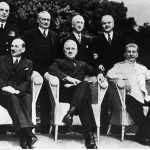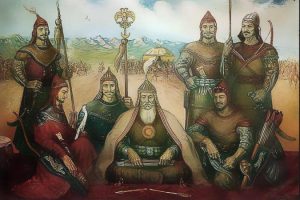 The Potsdam Conference, held from July 17 to August 2, 1945, was a crucial diplomatic gathering involving the leaders of the Allied powers at the end of World War II. Held in the suburb of Potsdam, near Berlin, the conference aimed to discuss the post-war settlement and shape the future of Europe and Asia. This article provides an overview of the Potsdam Conference and its significance in shaping the global landscape following the war.
The Potsdam Conference, held from July 17 to August 2, 1945, was a crucial diplomatic gathering involving the leaders of the Allied powers at the end of World War II. Held in the suburb of Potsdam, near Berlin, the conference aimed to discuss the post-war settlement and shape the future of Europe and Asia. This article provides an overview of the Potsdam Conference and its significance in shaping the global landscape following the war.
The Potsdam Conference was the third major meeting of the Allied leaders during World War II, following the Tehran Conference in 1943 and the Yalta Conference in 1945. The conference was attended by the heads of government of the United States, the Soviet Union, and the United Kingdom: President Harry S. Truman, Soviet Premier Joseph Stalin, and British Prime Minister Winston Churchill (later replaced by Clement Attlee).
Key Agreements and Decisions:
- Occupation and division of Germany: One of the major outcomes of the Potsdam Conference was the division of Germany into four occupation zones, to be administered by the United States, the Soviet Union, the United Kingdom, and France. This division set the stage for the subsequent Cold War between the Soviet Union and the Western powers.
- Reparations and war crimes: The conference addressed the issue of war reparations and punishment for war criminals. The leaders agreed that the Allied powers would extract reparations from Germany, primarily in the form of industrial dismantlement and forced labor. The conference also established the framework for the Nuremberg Trials, where prominent Nazi leaders were prosecuted for war crimes.
- Borders and territorial adjustments: The Potsdam Conference confirmed the Soviet Union’s control over Eastern Europe, which had been liberated by the Red Army during the war. It led to the establishment of new borders, resulting in significant territorial changes in Poland, as well as the annexation of parts of Germany by Poland and the Soviet Union.
- Demilitarization and denazification: The conference called for the demilitarization and denazification of Germany, aiming to eliminate the Nazi ideology and prevent Germany from becoming a military threat in the future. The process involved dismantling the German military and purging Nazi influence from German society.
- Declaration on Japan: During the conference, the Allies issued the Potsdam Declaration, demanding Japan’s unconditional surrender. The declaration outlined the terms for Japan’s surrender, including its disarmament, democratization, and the occupation of Japanese territories by the Allied powers.
The Potsdam Conference played a significant role in shaping the post-war world order. The decisions made at Potsdam, particularly regarding the division of Germany and the establishment of new borders, laid the groundwork for the subsequent division of Europe into two blocs during the Cold War. The conference also marked the beginning of a new era of superpower rivalry between the United States and the Soviet Union.
The Potsdam Conference of 1945 was a pivotal event in world history, determining the future of Europe and Asia after the end of World War II. The agreements reached at Potsdam had far-reaching consequences, shaping the geopolitical landscape for decades to come. The conference’s legacy can still be felt today, as the ramifications of the decisions made in Potsdam continue to influence international relations and global politics



















Add Comment